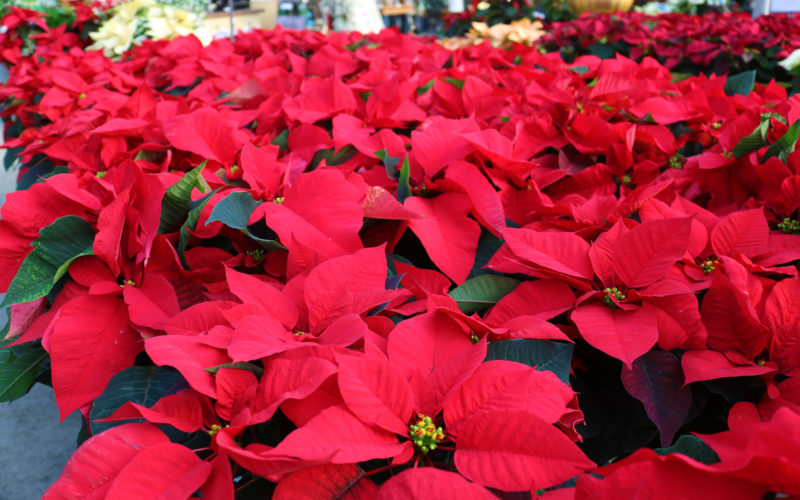Caring for Poinsettias During the Holidays and After

Before we get into poinsettia plant care, let’s begin with the enchanting poinsettia history. One Christmas Eve long ago, a little girl from Mexico named Pepita was sad. More than anything, she wanted to give a fine present to the Christ Child at the church service that evening. But, she was very poor and had no gift. As she walked sorrowfully to church with her cousin Pedro, he tried to console her. “Pepita,” he said, “I am certain that even the most humble gift given in love will be acceptable in His eyes.”
So Pepita gathered a bouquet of common weeds from the roadside and entered the church. As she approached the altar, her spirits lifted. She forgot the humbleness of her gift as she placed it tenderly at the feet of the Christ Child. Then, a miracle occurred as Pepita’s ordinary weeds burst into brilliant red blooms. They were called Flores de Noche Buena, Flowers of the Holy Night. We call them poinsettias.
Poinsettias are known all over the world as the flower of Christmas. Millions of poinsettias are purchased each year by people who enjoy the color and warmth they bring to a home.
Different Colors of Poinsettias
The top leaves of a poinsettia are called bracts, and they are the leaves that turn brilliant colors. Once there was only a red variety, but today there are over 100 varieties of poinsettias. Their colors that range from white and pink to blue and purple, and mixtures of colors that include everything in between.
At Stauffers, we offer several colors of poinsettias from traditional to dazzling. Here are a few you’ll find in our Home and Garden Stores.
Caring for You Holiday Poinsettias
Do Poinsettias Need Sunlight?
The most important steps in caring for poinsettias is making sure they have adequate light and receive proper warmth.
- Place your plants in a cool, bright location that receives at least four hours of direct sunlight.
The location should be free from drafts or artificial heat. Appliances (especially television sets), radiators, and ventilation ducts produce enough heat and air movement to damage your plants. - Poinsettias prefer nighttime temperatures between 55° and 65° and daytime temperatures around 70°.
- Be sure to cover your poinsettia with a protective paper sleeve if you are taking it outside when the temperatures are below 50°. A chilled plant will drop leaves very quickly and a frozen plant will turn black.
- When you purchase a poinsettia, it will come with a plastic paper or fiber protective sleeve. Remove the cover from the plant immediately upon arriving home.
How Often Should I Water a Poinsettia?
Keeping your plant adequately watered is another important step in caring for poinsettias. Check your poinsettia daily and water when the soil surface becomes dry. Water until the soil is evenly moist and there is water draining from the plant. Use a saucer to catch dripping water and protect the surface below.
Are Poinsettias Poisonous?
The poinsettia is not a poisonous plant. Research has proven that poinsettias are not lethal to humans or pets. However, your poinsettia and other houseplants should be kept out of reach of small children and animals since varying degrees of discomfort may be experienced if plant parts are ingested.
Helping a Poinsettia to Rebloom
We’re often asked about planting poinsettias outside after Christmas. Because these plants are so sensitive to light and temperature, it’s not ideal to plant them outside. However, they can be regrown year after year. Follow these special instructions to ensure that they rebloom properly.
In Late Spring (early May)
- Cut back your plant to 6”.
- Shake it free of soil and replant in new potting soil.
- Resume regular watering.
- Fertilize with a 30-10-10 mix every two weeks.
- Place outdoors in a warm, sunny location that’s a minimum of 60°.
- Pinch tips off new shoots when 6” – 8” long.
- In late July, cut back to 5” – 6”.
In Late Summer (early September)
- Bring indoors before evening temperatures begin to drop.
- Place in full sun (East, West, or South exposure). Make sure your plant gets three to six hours of direct sun each day.
- Continue to fertilize every two weeks.
In Fall (late September – October)
- In order for poinsettias to bloom, they must have 14 hours of uninterrupted darkness each day for 40 days.
- Place in a dark place, such as a closet or cover with a polythene bag in the early evening (sunset) and then remove the next morning (sunrise) so that the plant is kept in total darkness. Continue daily for 8 weeks and then treat normally.
- Stop fertilizing from November 1 to December 30.
When you follow a proper light deprivation schedule, your poinsettia should rebloom by Christmas. But remember, even the smallest amounts of artificial light (10 minutes each day) during the blackout period can delay blooming until January or February.
Visit Stauffers Home & Garden Stores to shop a beautiful selection of poinsettia varieties — perfect for decorating your home or giving as a gift.
